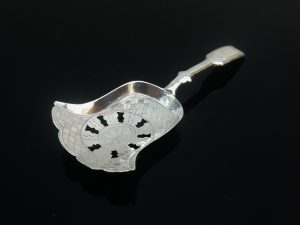Description
Antique Sterling Silver Table Dinner Fork
English antique sterling silver table dinner fork by William Rawlings Sobey, hallmarked from Exeter in 1837.
Engraved above the well preserved hallmarks with a family crest that we have not researched.
Light wear to the tine tips (minimal) otherwise in very fine order.
Measures 193mm in length.
| DATE | 1837 |
| MAKER or SPONSOR MARK | William Rawlings Sobey |
| ASSAY OFFICE | Exeter |
| WEIGHT (Grammes) | 60.6 |
| WEIGHT (Troy) | 1.94 |
| REF:- | 435G – 435H |
Assay marks for Exeter date back to the middle of the 16th Century with the mark of origin in the form of a letter X in a round shield surmounted by a Crown. The Exeter Assay Office was officially established in 1701 by Act of Parliament. It became the Assay Office of choice for goldsmiths and silversmiths, not only of Exeter, but also across Devon and the neighbouring counties of Cornwall, Somerset and Dorset.
The first date letter, A, was used until 7th August 1702. The date letter then changed either on the anniversary of that date or on the day of election of new wardens for the following year.
The Exeter town mark was initially based on the coat of arms of the city, that being a castle with three turrets. This looks very similar to that of Edinburgh, but can be differentiated by the existence of the Britannia Mark and the Lion’s Head erased. After 1721 the Exeter town mark changed to the Leopard’s Head and the Lion Passant in square shields.
Unfortunately, the requirement for assaying was much reduced during the third quarter of the 19th century and the Assay Office finally closed its doors in 1883.














